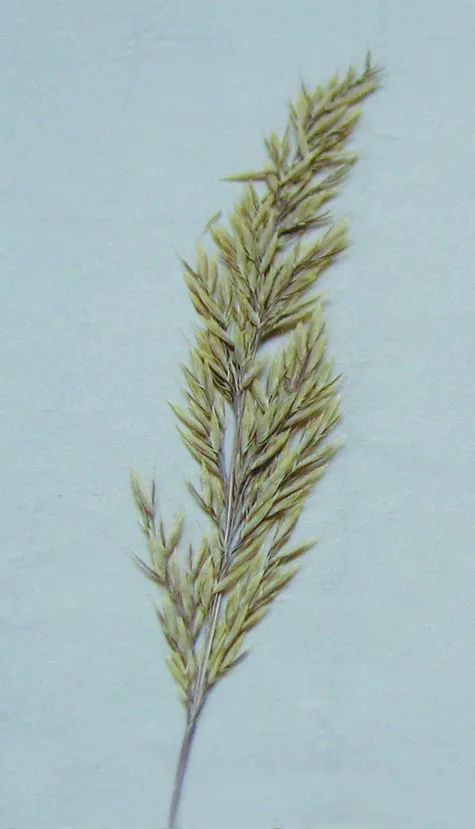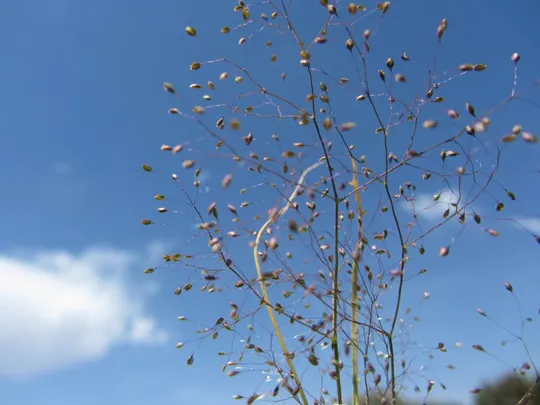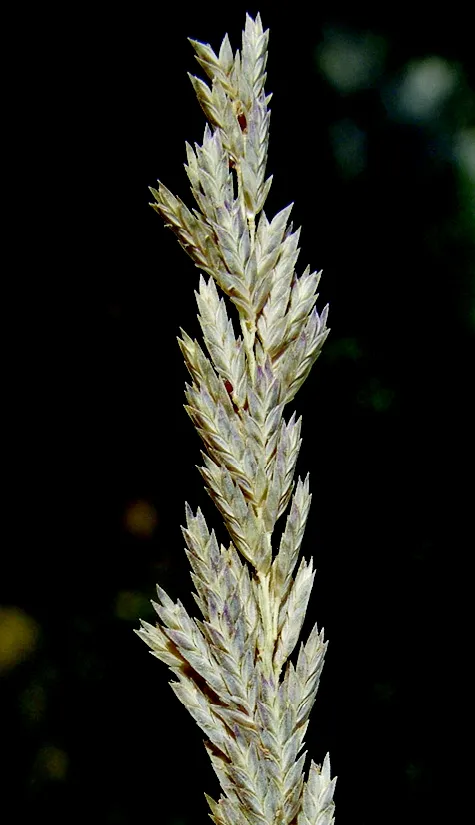Anthephora laevis
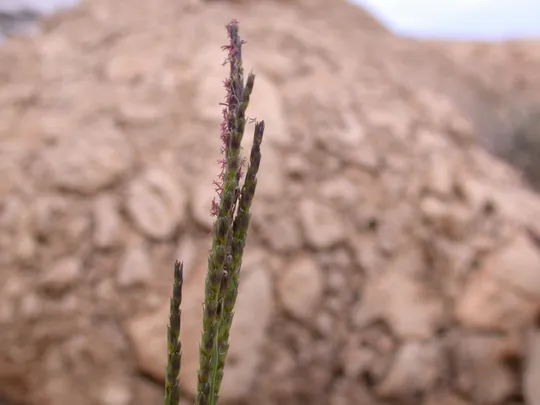
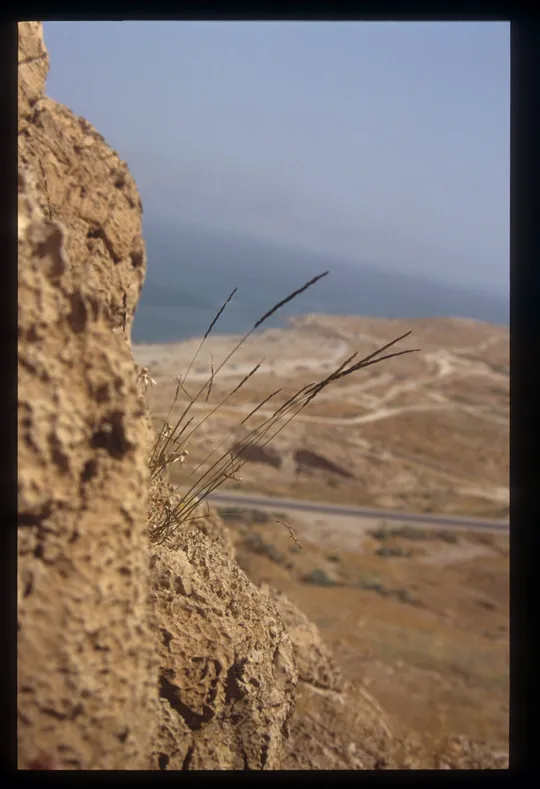
Anthephora laevis grows in the
Judean desert near the Dead Sea at a single site in the cliffs above the Madin
Ruins. There are an estimated two sites in Israel. The species was discovered
for the first time in 1980 on the cliffs above the large Ziziphus at the
Madin Ruins. The species was not found in the 1990s and was believed to be
extinct, but on March 5, 2002 three blooming individuals were found at exactly
the same spot. Efforts to find other population along the cliffs of the Judean
Desert and the Elat Mountains were unsuccessful, even though the plant can be
easily identified by its narrow long glabrous inflorescence that bears black
spikelets.
Rock pockets on hard
limestone stepped cliffs, on steep slopes along the Dead Sea shores. The area
has an annual precipitation of 100 mm and extremely high summer temperatures.
The genus
Anthephora consists of twelve
perennial herbaceous Gramineae (Poaceae) species (only one is an annual),
growing mostly in Equatorial Africa with only one species growing in South
America. Within the Gramineae (Poaceae) family the genus belongs to the
Paniceae tribe, which has a characteristic densely flowered panicle
inflorescence, in which each spikelet contains one fertile flower and an
additional sterile flower. Among the tribe’s genera, Anthephora is close systematically to the genus
Pennisetum but the shape of its inflorescence is not indicative of this.
After A. laevis was found in 1980, Prof. Feinbrun
sent the plant to two international experts on the Gramineae (Poaceae) family
for identification. It was determined to be A. laevis, an African species that grows in Central Africa
and up to Somalia. A.
laevis is not mentioned in the Gramineae (Poaceae) family in the Flora of Somalia from 1995, nor
in the Flora of Yemen.
A.
laevis exemplifies the distribution pattern of many Sudanian plants
growing in the African savanna whose distribution reaches the Dead Sea region
along the Syrian-African Rift. Additional species of this kind are Moringa
peregrina, Commicarpus sinuatus, Maerua crassifolia, Grewia villosa, Enneapogon
persicus and Leptadenia pyrotechnica. Some are relatively common
along the mountain ranges and extreme desert plains along the Red Sea beaches, where
they enjoy the high temperature and those micro-habitats that have enough
water. The Sudanian shrubs and trees inhabit mostly oasis, and deep wadis. The
perennial Gramineae (Poaceae), characteristic of open spaces between the trees in
African savannas, do not reach the groundwater in the wadi beds to and often
survive in soil pockets on cliffs and rocky slopes. Some of them are relatively
common such as Pennisetum, Tetrapogon, Aristida and Tricholaena.
Others are extremely rare plants such as Enneapogon persicus and Anthephorea laevis.
The latter exhibits impressive geographical disjunction, such as that found in Aacia
laeta which is also found in the Dead Sea area and whose closest population
is found 2000 km south of our region. The disjunction distance of A. laevis is even greater and the closest area from which the species is know is
Sudan and Kenya. This is the greatest geographical disjunction we know of in
the Flora of Israel.
Anthephora laevis plant grows at a
single site and the small number of plants (three) exposes it to random
extinction. The plant is protected in HaHe'etekim Cliff Nature Reserve.
The Anthephora
laevis
population at its single site should be monitored and plants
propagated in the refuge garden at the En Gedi Nature Reserve.
According to the
Flora Palaestina Anthephora
laevis has a Sudanian distribution, but the species is not
mentioned in the Flora of East Africa and of the Horn of Africa. In its place
four other species of Anthephora are noted from East Africa, two of which also grow on the
Horn of Africa and their distribution crosses the Red Sea eastwards towards
Yemen and Arabia (A. nigritana is similar to our taxon, but has hairy
glumes). A. laevis is known from the Flora of Tropical Africa from Mali and
Nigeria. It does not grow in countries neighboring Israel – Egypt, Sinai and
the Arabian Peninsula.
Anthephora laevis is a perennial
African grain that grows on the Judean Desert cliffs near the Dead Sea whose
population numbers only a few plants at a single site in the country – an
extreme northern point of the species global range, fragmented from its main
distribution area in Africa with the largest geographical disjunction known
between Sudanian plants in Israel.
שמידע, א ואור, י. 1983. הצמחייה הסודנית בישראל. רתם 8: 1-107.
שמידע, א. 1986. הצמחייה הסודנית - פלישה חדשה או שריד מיוקני קדום. רתם 20: 76-111.
Shmida, A. and A. Aronson, 1986. The Sudanian elements in the flora of Israel. Ann. Missouri Bot. Gardens 73: 1-28.
Current Occupancy Map
| 1000 squre meter pixel | 5000 squre meter pixel | 10000 squre meter pixel | |
|---|---|---|---|
| number of observations | 0 | 0 | 0 |
| in total pixels | 0 | 0 | 0 |
| Family | Gramineae |
| Classification | On the endangered species list |
| Ecosystem | Desert |
| Chorotype | Sudanian |
| Conservation Site | Madin Ruins |
| Rarity |
1
6
6
|
|---|---|
| Vulnerability |
0
0
4
|
| Attractiveness |
0
0
4
|
| Endemism |
0
0
4
|
| Red number |
1
3.7
10
|
| Peripherality | S |
| IUCN category | DD EW EX LC CR EN VU NT |
| Threat Definition according to the red book | Vulnerable |
 Based on:
Based on:
